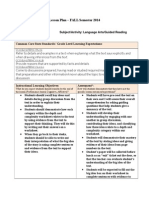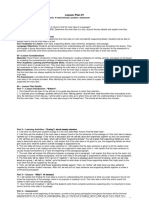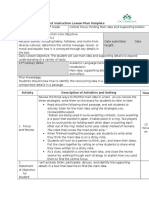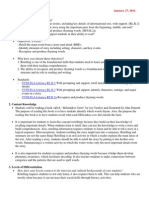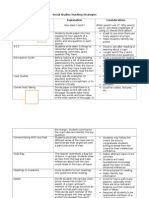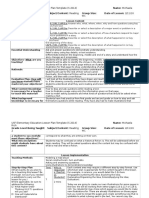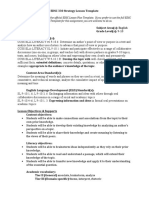0 ratings0% found this document useful (0 votes)
152 viewsMain Idea Lesson Template
Main Idea Lesson Template
Uploaded by
api-275591103This document outlines a unit plan for teaching 4th grade students about identifying main ideas and supporting details in texts. The unit lasts around 1.5 weeks and uses various activities and formative assessments. Students will learn key concepts like differentiating main ideas from supporting/irrelevant details. They will practice these skills by filling out graphic organizers, sorting words by topic, and analyzing short passages. The performance task requires students to extract main ideas and details from multi-paragraph readings. Formative assessments ensure comprehension is developing correctly throughout the unit.
Copyright:
© All Rights Reserved
Available Formats
Download as PDF, TXT or read online from Scribd
Main Idea Lesson Template
Main Idea Lesson Template
Uploaded by
api-2755911030 ratings0% found this document useful (0 votes)
152 views4 pagesThis document outlines a unit plan for teaching 4th grade students about identifying main ideas and supporting details in texts. The unit lasts around 1.5 weeks and uses various activities and formative assessments. Students will learn key concepts like differentiating main ideas from supporting/irrelevant details. They will practice these skills by filling out graphic organizers, sorting words by topic, and analyzing short passages. The performance task requires students to extract main ideas and details from multi-paragraph readings. Formative assessments ensure comprehension is developing correctly throughout the unit.
Original Title
main idea lesson template
Copyright
© © All Rights Reserved
Available Formats
PDF, TXT or read online from Scribd
Share this document
Did you find this document useful?
Is this content inappropriate?
This document outlines a unit plan for teaching 4th grade students about identifying main ideas and supporting details in texts. The unit lasts around 1.5 weeks and uses various activities and formative assessments. Students will learn key concepts like differentiating main ideas from supporting/irrelevant details. They will practice these skills by filling out graphic organizers, sorting words by topic, and analyzing short passages. The performance task requires students to extract main ideas and details from multi-paragraph readings. Formative assessments ensure comprehension is developing correctly throughout the unit.
Copyright:
© All Rights Reserved
Available Formats
Download as PDF, TXT or read online from Scribd
Download as pdf or txt
0 ratings0% found this document useful (0 votes)
152 views4 pagesMain Idea Lesson Template
Main Idea Lesson Template
Uploaded by
api-275591103This document outlines a unit plan for teaching 4th grade students about identifying main ideas and supporting details in texts. The unit lasts around 1.5 weeks and uses various activities and formative assessments. Students will learn key concepts like differentiating main ideas from supporting/irrelevant details. They will practice these skills by filling out graphic organizers, sorting words by topic, and analyzing short passages. The performance task requires students to extract main ideas and details from multi-paragraph readings. Formative assessments ensure comprehension is developing correctly throughout the unit.
Copyright:
© All Rights Reserved
Available Formats
Download as PDF, TXT or read online from Scribd
Download as pdf or txt
You are on page 1of 4
Title:
Grade:
Main Idea Overview
Subject:
4th
Designer:
Language Arts- Main Idea
Sarah Worth
Stage 1 Desired Results
Established Goals: Students will demonstrate comprehension of fictional texts through
identifying the main idea and supporting details (4.5j).
Understandings:
Essential Understanding
Students will understand:
Being able to pick out the main idea and supporting
details of texts can help create analytical, forward
thinking learners.
That being able to identify the
main idea and supporting details
will help them become more
analytical and critical thinkers.
Being able to master the ability to
identify main idea and supporting
details will increase effective note
taking skills.
The main idea of a passage is what the passage is
mostly about. Supporting details can be used to help
explain or defend what the main idea is.
Essential Questions:
Students will know
Basic text structures that can be
found in fictional texts.
How can you identify the main idea of a
passage?
Why are supporting details important?
How can you tell which details are
important in a given passage?
Students will be able to
Define the terms main idea and supporting
details
Identify the main idea and supporting details
of a given passage.
Identify which parts of a passage are
irrelevant, based on the main idea and
supporting details.
Stage 2 Assessment Evidence
Performance Tasks: For the next
Other Evidence:
several days, we will talk about what the
main idea is for a piece of writing as well Throughout the week, student comprehension will be
as its supporting details. Throughout the
assessed through small group observation and
next week and a half, you will learn how
whole group instruction. Students will be prompted
to identify the main idea, which details in to recall, review, and explain what the main idea is
a passage are used to support the main
as well as which details in the passage support the
idea, as well as how to tell which parts of main idea. They will need to be able to differentiate
a passage are irrelevent
between necessary and unnecessary information as
well as create supporting details based off of a main
idea. At the end of the week, a short assessment will
be given to assess student comprehension at the end
of the mini-unit.
Stage 3 Learning Plan
Learning Activities:
Monday: Introduction to Main Idea
Tuesday: Table Activity
Explain to students that for todays activity, they will be read a story aloud and will need to
fill out a table cut out with the main idea and supporting details. Place a filled out copy of
yesterdays notes sheets on the Elmo. Point out how the center of the table is found as well as
what each table leg represents. Read the story Stone Soup out loud to the students. Read
slowly so they have time to process and pick apart the information. Pass out the table document
and have students cut out the table. Explain that the teacher will be reading the book again, and
this time students will be filling in the information on their table. Once the story has been read a
second time, students will be allowed to work together to help each other fill out their table.
Have students keep the table in their binder for future references.
Wednesday: Cutting and Sorting main Idea
Today, the students will be looking at different words or phrases that have a common
similarity. Each of the words will be mixed up on the piece of computer paper. Students will cut
out each of the words and organize them into three groupings that makes sense to them. Once
they have three categories, they must figure out what the main idea is, based on that. Remind
students that the main idea is the most important part of a passage. Once they have organized
their sorts, they can glue the sort in three different lists on a sheet of construction paper. Make
sure to remind students to write down what their main idea is, or their sort, at the top of the
paper. Have the students turn in their construction paper in the turn in basket when complete.
Thursday: Rikki Tikki Tavi Passage
Explain to students that today we will be discussing how to pick part the main idea and
supporting details of multi-paragraph passages. Tell the students that the same strategies we
used for creating the table and sorting the terms can be used to find the main idea and
supporting details in this paragraph as well. Give each student a copy of the Rikki Tikki Tavi
passage and have them work independently. This will serve as a measurement of comprehension
to see how well students are able to pick apart a passage similar to that they will see on the SOL
and identify the main ideas.
Friday: Main Idea Flip Chart with unnecessary information.
Open the flipchart to the slide which discusses unnecessary information. Explain to the
students that once they are able to identify what the main idea for a certain passage is, they will
then be able to figure out which sentences are not supporting details and may be irrelevant. Go
through some of the examples with the class all together, asking them to explain how they knew
which sentences were not supporting details. Then, give out the worksheet to each student.
Explain that they will be asked to underline the sentence in the passage that does not relate to the
main idea. Have them turn the papers in to the turn in basket when completed.
Monday Divided computer paper assignment
For this assignment, students will be given a main idea and will need to create their own
details that would support that main idea. Place a sheet of computer paper on the Elmo and
section it off into four quadrants. Write one main idea at the top of each section. Next,
brainstorm with the students what one supporting detail for each section could be. Write that
example down and have the students copy the sentences as well. Explain that they will be
working in pairs to create three additional supporting detail sentences for each of the main idea
sections.
Tuesday: Assessment
Take a few minutes to do a quick review of what the students have studied during the main
ideas and supporting details unit. Pass out the corals and explain to the students that this is an
assessment, which means it will be a zero noise activity. Hand out the assessments and have
students turn in their assessment to the turn in basket when completed.
You might also like
- Main Idea Imb Final Lesson Plan WeeblyDocument8 pagesMain Idea Imb Final Lesson Plan Weeblyapi-313448133100% (1)
- PASSMEDICINE MCQs-PALLIATIVE CAREDocument22 pagesPASSMEDICINE MCQs-PALLIATIVE CAREImran Chaudhry100% (3)
- Read 3226 Clinical LessonDocument8 pagesRead 3226 Clinical Lessonapi-251731664No ratings yet
- Gate LessonDocument5 pagesGate Lessonapi-283979987No ratings yet
- Revised Summarizing LessonsDocument25 pagesRevised Summarizing Lessonsapi-251432137No ratings yet
- Hall Task1 LPDocument13 pagesHall Task1 LPapi-297798957No ratings yet
- Jaime Allen Direct Instruction Lesson Plan TemplateDocument6 pagesJaime Allen Direct Instruction Lesson Plan Templateapi-300830751No ratings yet
- Jones Megan Lesson Plan Comments-2Document4 pagesJones Megan Lesson Plan Comments-2api-384661405No ratings yet
- Read 3226 Whole Class Lesson Plan - Main Idea and Key DetailsDocument6 pagesRead 3226 Whole Class Lesson Plan - Main Idea and Key Detailsapi-217043801No ratings yet
- How To Work With ReadingDocument5 pagesHow To Work With ReadingAlinfa1No ratings yet
- Lesson 3Document3 pagesLesson 3api-245823147No ratings yet
- 5th - Main IdeaDocument55 pages5th - Main IdeagerawenceNo ratings yet
- Student Teaching Edtpa Lesson Plan TemplateDocument2 pagesStudent Teaching Edtpa Lesson Plan Templateapi-402226449No ratings yet
- Understanding by Design Unit TemplateDocument5 pagesUnderstanding by Design Unit Templateapi-318155534No ratings yet
- 1 StobDocument4 pages1 Stobapi-257228749No ratings yet
- Direct Instruction Lesson Plan TemplateDocument4 pagesDirect Instruction Lesson Plan Templateapi-282824279No ratings yet
- ReadinglessonDocument5 pagesReadinglessonapi-299634543No ratings yet
- WritingDocument3 pagesWritingapi-220399298No ratings yet
- UnitDocument9 pagesUnitapi-270112279No ratings yet
- Topic Sentences LPDocument5 pagesTopic Sentences LPapi-252410182No ratings yet
- Main Idea UbdDocument12 pagesMain Idea Ubdapi-253205044No ratings yet
- Direct Instruction Lesson Plan TemplateDocument5 pagesDirect Instruction Lesson Plan Templateapi-282143950No ratings yet
- Kim Greco Sarah Macholdt Literacy Lesson Plan Term 3-2pdfDocument4 pagesKim Greco Sarah Macholdt Literacy Lesson Plan Term 3-2pdfapi-341095033No ratings yet
- Edtpa-Aligned Lesson For All ClassesDocument12 pagesEdtpa-Aligned Lesson For All Classesapi-267736442No ratings yet
- Tkam Lesson4Document5 pagesTkam Lesson4api-257595875No ratings yet
- Eled 4122 - Edtpa Video Lesson Plan TemplateDocument2 pagesEled 4122 - Edtpa Video Lesson Plan Templateapi-283076872No ratings yet
- Lit Lesson Plan HickmanDocument13 pagesLit Lesson Plan Hickmanapi-583080295No ratings yet
- Writing UnitDocument15 pagesWriting UnitAnonymous DPwpbRI7ZKNo ratings yet
- Classroom Modeling - PhippsDocument8 pagesClassroom Modeling - Phippsapi-399906068No ratings yet
- Teaching Reading Theory 20 Copies PDFDocument7 pagesTeaching Reading Theory 20 Copies PDFDN MukhiyaNo ratings yet
- Reflective Lesson Plan Main IdeaDocument6 pagesReflective Lesson Plan Main Ideanscmanigault100% (1)
- "Building Main Idea" Grade Level/Subject: Standards Targeted: CCSS - ELA-Literacy - RI.6.2Document5 pages"Building Main Idea" Grade Level/Subject: Standards Targeted: CCSS - ELA-Literacy - RI.6.2api-290076952No ratings yet
- Shared Reading Week of 0127Document10 pagesShared Reading Week of 0127api-241777721No ratings yet
- Social Studies Teaching StrategiesDocument4 pagesSocial Studies Teaching Strategiesapi-280000855No ratings yet
- Expository Lesson PlanDocument6 pagesExpository Lesson Planapi-265180782100% (2)
- Lesson 2 450Document7 pagesLesson 2 450api-257595875No ratings yet
- Mystery Unit Drawing Conclusions Lesson Plan 3 - UpdatedDocument4 pagesMystery Unit Drawing Conclusions Lesson Plan 3 - Updatedapi-285360604No ratings yet
- Assignment 2Document10 pagesAssignment 2api-266024838No ratings yet
- Reading Comprehension SkillsDocument21 pagesReading Comprehension SkillsColinNo ratings yet
- Midnight's Children LPA #1Document10 pagesMidnight's Children LPA #1midnightschildren403No ratings yet
- Ela Edtpa LessonDocument5 pagesEla Edtpa Lessonapi-313445058No ratings yet
- Read 550 Bda Lesson PlanDocument6 pagesRead 550 Bda Lesson Planapi-404203709No ratings yet
- Weebly Lesson Plan 2Document3 pagesWeebly Lesson Plan 2api-316101371No ratings yet
- Curriculm MapDocument11 pagesCurriculm Mapapi-316343255No ratings yet
- Ela Reflective Lesson Plan 4Document9 pagesEla Reflective Lesson Plan 4api-339778322No ratings yet
- College of Saint Mary Lesson Plan Format With Lesson ReflectionDocument13 pagesCollege of Saint Mary Lesson Plan Format With Lesson Reflectionapi-280302462No ratings yet
- Ed 321 Final Obs LessonDocument2 pagesEd 321 Final Obs Lessonapi-252924047No ratings yet
- Reading Activities TrainingDocument11 pagesReading Activities TrainingIsrael GarciaNo ratings yet
- Strategy Lesson 1Document5 pagesStrategy Lesson 1api-484708169No ratings yet
- 2 11 Aunt SusanDocument4 pages2 11 Aunt Susanapi-308910909No ratings yet
- Millicent Atkins School of Education: Common Lesson Plan TemplateDocument10 pagesMillicent Atkins School of Education: Common Lesson Plan Templateapi-346719524No ratings yet
- 6 1 UnitDocument15 pages6 1 Unitapi-302505821No ratings yet
- Argh WeplanfinalDocument9 pagesArgh Weplanfinalapi-266085341No ratings yet
- TechlessonplanDocument4 pagesTechlessonplanapi-284926914No ratings yet
- Baikd Part BDocument14 pagesBaikd Part Bapi-317153463No ratings yet
- Edsc 330 Strategy Presentation Lesson Template - Lessonone 07Document4 pagesEdsc 330 Strategy Presentation Lesson Template - Lessonone 07api-501747711No ratings yet
- Detailed Lesson Preparation Guide: Elementary EducationDocument3 pagesDetailed Lesson Preparation Guide: Elementary Educationapi-355728225No ratings yet
- 3rd Grade Guided Reading LessonDocument4 pages3rd Grade Guided Reading Lessonapi-543821252100% (1)
- Action Research Lesson Week 2Document5 pagesAction Research Lesson Week 2api-510441034No ratings yet
- Lesson Plan TemplateDocument5 pagesLesson Plan Templateapi-298026665No ratings yet
- Informational Text Toolkit: Research-based Strategies for the Common Core StandardsFrom EverandInformational Text Toolkit: Research-based Strategies for the Common Core StandardsNo ratings yet
- A Shady Plot Is A Short Ghost Story by ElsieDocument18 pagesA Shady Plot Is A Short Ghost Story by ElsieNaampreet Singh0% (1)
- What Is The Assessment Based National Dialogue (ABND) and How It WorksDocument30 pagesWhat Is The Assessment Based National Dialogue (ABND) and How It WorksAdithyaNo ratings yet
- Islamic Studies MCQS Upto 2005 2018 PDFDocument28 pagesIslamic Studies MCQS Upto 2005 2018 PDFClearDiamondNo ratings yet
- Basic Elements of Equipment Cleaning and Sanitizing in Food Processing and Handling OperationsDocument11 pagesBasic Elements of Equipment Cleaning and Sanitizing in Food Processing and Handling OperationsMurtaza ÇakaloğluNo ratings yet
- Write On Care and Maintenance of FabricsDocument8 pagesWrite On Care and Maintenance of FabricsmadhugangulaNo ratings yet
- Tube MillDocument43 pagesTube MillHamed MostafaNo ratings yet
- Open Price Close PriceDocument3 pagesOpen Price Close Priceanita mahajanNo ratings yet
- Employee Performance EvaluationDocument6 pagesEmployee Performance Evaluationsoundar rajNo ratings yet
- Tarea 1Document11 pagesTarea 1Vladimir KijimaNo ratings yet
- Reading List 2007Document9 pagesReading List 2007irineugianesiNo ratings yet
- DOC697 Rev G YASARAGIL Aneurysm Clip System BrochureDocument48 pagesDOC697 Rev G YASARAGIL Aneurysm Clip System BrochureJosé Javier CalderonNo ratings yet
- List of RFI Raised As On 16.08.2020Document2 pagesList of RFI Raised As On 16.08.2020Abhinandan MazumderNo ratings yet
- MBA7068 -Academic Skills and Professional Practice Assignment HelpDocument15 pagesMBA7068 -Academic Skills and Professional Practice Assignment HelppunjabassignmenthelpausNo ratings yet
- Practice Set Ibps Cwe Clerk-IVDocument14 pagesPractice Set Ibps Cwe Clerk-IVDinesh Kumar Rout0% (1)
- Chapter 8 - NotesDocument20 pagesChapter 8 - NotesPraneethNo ratings yet
- Standard 5381Document1 pageStandard 5381atul sachanNo ratings yet
- Activity 2 - Moving AveragesDocument4 pagesActivity 2 - Moving AveragesMei MCasNo ratings yet
- Assignment L01 (Thursday, 11.30 Am) Marking SchemeDocument12 pagesAssignment L01 (Thursday, 11.30 Am) Marking SchemeMawareNo ratings yet
- Burt Berkson, MD, PHD - Curing-Stage-4-Cancer-And-Terminal-Liver-DiseaseDocument14 pagesBurt Berkson, MD, PHD - Curing-Stage-4-Cancer-And-Terminal-Liver-Diseaseguy777No ratings yet
- Certificado - SUN-25K À SUN-50KDocument1 pageCertificado - SUN-25K À SUN-50KJhulia Maria Nogueira Rodrigues de Oliveira - Blue Sol EnergiaNo ratings yet
- Chemistry of The Elements (2nd Edition)Document14 pagesChemistry of The Elements (2nd Edition)mycomiccityNo ratings yet
- Kutztown TranscriptDocument3 pagesKutztown Transcriptapi-438989302No ratings yet
- MKTG Analytics-Final ProjectDocument46 pagesMKTG Analytics-Final Projectapi-728810138No ratings yet
- Abrites Diagnostics For Mercedes OnlineDocument14 pagesAbrites Diagnostics For Mercedes OnlineGarvin Alberto Sandrea ParisNo ratings yet
- Kegel Exercises 4 Pelvic Floor MusclesDocument10 pagesKegel Exercises 4 Pelvic Floor MusclesSHAIK SHABEENA100% (1)
- Society of Spanish & Spanish-American Studies Anales de La Literatura Española ContemporáneaDocument19 pagesSociety of Spanish & Spanish-American Studies Anales de La Literatura Española ContemporáneaLl JournalNo ratings yet
- Integrity Policies: CS691 - Chapter 6 of Matt BishopDocument28 pagesIntegrity Policies: CS691 - Chapter 6 of Matt BishopSana MaNo ratings yet
- BLDC 1500 2018 BC Building Code-Part 9 Single Family Dwelling BuildingsDocument12 pagesBLDC 1500 2018 BC Building Code-Part 9 Single Family Dwelling BuildingsHamza TikkaNo ratings yet
- Dokumen - Tips Tube Wells and Their DesignDocument60 pagesDokumen - Tips Tube Wells and Their DesignEng Ahmed abdilahi IsmailNo ratings yet



